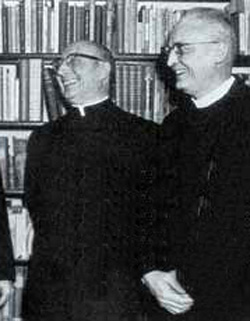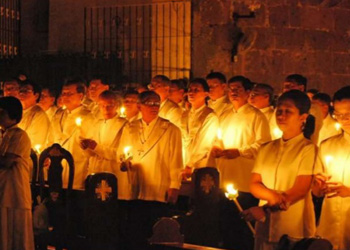Traditionalist Issues
 |
 |
 |
 |
 |
 |
 |
Dialogue Mass - LXIII
The 1956 Reform Revealed a New Ecclesiology
It is an unfortunate fact that most Catholics today, even among traditionalists, have no conception of the true nature and extent of the 1956 Holy Saturday reform. There is still virtually no grasp of what was at stake: the intended subversion of the traditional rite by progressivist reformers through the medium of “active participation.”
The perfect ‘insider job’
While virtually the whole Church was peacefully following the Roman Rite under Pius XII without evincing the least dissatisfaction, the Congregation of Rites was enthusiastically stirring the pot that would later be served up at Vatican II.
 That this was originally the work of the 1948 Commission is obvious from the fact that the 1955 Decree Maxima Redemptionis was signed by Card. Micara in his dual capacity as Pro-Prefect of the Congregation of Rites and President of the Commission. Fr. Löw was not only a member of the Commission but, as Vice-Relator of the Congregation of Rites, he was also responsible for editing and presenting the Commission’s ideas to the rest of the Congregation.
That this was originally the work of the 1948 Commission is obvious from the fact that the 1955 Decree Maxima Redemptionis was signed by Card. Micara in his dual capacity as Pro-Prefect of the Congregation of Rites and President of the Commission. Fr. Löw was not only a member of the Commission but, as Vice-Relator of the Congregation of Rites, he was also responsible for editing and presenting the Commission’s ideas to the rest of the Congregation.
Another leading Commission member, Fr. Antonelli, would soon be appointed as Relator-General to the Congregation of Rites (1956), prior to becoming Secretary of the Conciliar Commission for the Liturgy (1962) and Secretary of the Congregation of Rites (1965).
This means that the papal Commission was effectively given the power to dictate the reforms on the basis of nothing more than their own prejudices and, furthermore, that Pius XII allowed the inventions of the reformers to take precedence over the rights of the faithful to their own Tradition.
The new governing principle: activities for the people
Fr. Godfrey Diekmann, O.S.B., a key member of the Liturgical Movement, noted in 1953:
 “Especially noteworthy is the eagerness of the Holy See to encourage the intelligent and active assistance of the congregation. It is for this reason that most of the changes have been introduced: all are to receive and hold the flame from the Easter Candle; all are to join in the responses and in the Litany [of the Saints]; all are to hear and understand the readings; all are to renew their baptismal promises; the services are so arranged in the sanctuary that all may see, etc.” [emphases added] (1)
“Especially noteworthy is the eagerness of the Holy See to encourage the intelligent and active assistance of the congregation. It is for this reason that most of the changes have been introduced: all are to receive and hold the flame from the Easter Candle; all are to join in the responses and in the Litany [of the Saints]; all are to hear and understand the readings; all are to renew their baptismal promises; the services are so arranged in the sanctuary that all may see, etc.” [emphases added] (1)
It is obvious that this was an overarching, “totalizing” program of reform, leaving no member of the laity unaffected, no individual immune from moral coercion or even harassment. Its implications went far beyond the practicalities of whether to stand or sit, light a candle, use Latin or the vernacular.
It was fundamentally about a new ecclesiology, what kind of Church was being planned for the future – one, as it turned out, in which the whole idea of the sacramental Priesthood was to be merged seamlessly into that of the People of God actively engaged around the altar.
Liturgical gimmickry
In the Renewal of Baptismal Promises, the people engage in “active participation” by re-lighting their candles – which they had lit and extinguished only a short while earlier – passing the flame on to others in the congregation, balancing a book in one hand and a burning candle in the other, supervising one’s children precariously holding lighted candles, listening and responding to the priest in a “dialogue” and joining him in the communal recitation of the Our Father (as on Good Friday).
Juggling so many balls in the air and jumping through various hoops takes the soul, mind and body away from the necessary focus on Christ and from contemplative prayer. One may well ask: Where did the Mystery go? For while the mind is concentrating on these sundry distractions and novelties, and while the people are busy thinking of themselves, the whole focus of the Easter Vigil – contemplating the Death and Resurrection of Christ – is pushed aside.
An admission of failure
Even the liturgical pioneer, Fr. Clifford Howell, who enthusiastically welcomed the Holy Week reforms, could not fail to notice the superficiality of the Easter Vigil novelties including the innovative Renewal of Baptismal Promises and their inability to move the soul. He expressed his concern about what would happen when the initial effects had worn off:
 “It may well be that the people have been delighted with the novelty, with its picturesqueness, with the thrill of having something interesting to watch and to do, with the impressiveness of the gradual spread of the candle flames in the darkened church. They have been captivated, indeed: but perhaps, as yet, only with the externals...
“It may well be that the people have been delighted with the novelty, with its picturesqueness, with the thrill of having something interesting to watch and to do, with the impressiveness of the gradual spread of the candle flames in the darkened church. They have been captivated, indeed: but perhaps, as yet, only with the externals...
"It is imperative, therefore, that the appreciation that the faithful now have of this ceremony should be deepened; they must be helped to penetrate through these externals, and to achieve that renewal of mind and heart and will, which alone constitutes the genuine good of their souls.” (2)
In other words, in spite of the pyrotechnics (huge, leaping bonfires lighting up the night sky, the plethora of flickering candles in a darkened church), the effect could hardly be described as a flood of illumination into the soul.
But, what we do know, however, is that the Church had been remarkably successful throughout the centuries in providing for the sanctification of the faithful in the Mass and the Sacraments, as evidenced by the countless saints and pious souls who had received their spiritual sustenance thereby. For, the traditional lex orandi was the single most effective vehicle ever devised for achieving that goal – which raises the question as to why the reform was considered necessary in the first place.
Yet, these innovations, despite their manifest flaws, were given exclusivity and predominance over the tried and tested rituals of Tradition.
A meaningful reform?
The 1956 Renewal of Baptismal Promises was not without inherent problems in comprehensibility, notwithstanding the use of the vernacular, which was supposed to make the liturgy easier for the people to understand.
 The fundamental problem is the corporate nature of the so-called Renewal in which the people respond in the plural, “we do / we believe,” when asked if they renounce Satan and accept certain articles of the Faith.
The fundamental problem is the corporate nature of the so-called Renewal in which the people respond in the plural, “we do / we believe,” when asked if they renounce Satan and accept certain articles of the Faith.
To begin with, no one can confess another’s faith, for no one ‒ apart from God ‒ knows what all the others actually believe. What one believes may be different from what the person next to him believes, so that “we” may not always be of one mind.
Similarly for the promises: as they presuppose the full consent of the individual will, no one can vouch for others in the congregation who shout out promises they may or may not sincerely mean.
Clearly, then, the Renewal of Baptismal Promises raises problems of an epistemological nature, which illustrate the incoherence of the reformers’ avowed intention to create a “more meaningful” liturgy to enable the “intelligent participation” of the laity. It also highlights the futility of giving the congregation a vocal role in the liturgy.
The battle of ‘I’ versus ‘we’
Ever since 1956, and right up to the present day, a controversy has been raging over whether to use “I” or “we” in the liturgy, with the progressivists favoring the latter because of its “communitarian” significance. (3)
Some traditionalists, wishing to continue the 1956 reforms while at the same time realizing the spurious nature of these community-based activities, switched to the use of “I” instead of “we.” But they do so on their own initiative, for the plural forms in Latin ‒ abrenuntiamus (we do renounce) and credimus (we believe) ‒ are contained in the 1962 Missal.
It is noteworthy that the response abrenuntiamus – a six-syllable tongue-twister that many people could only pronounce with difficulty and after much practice, while some could not manage to do so at all – can hardly be said to lend itself to congregational participation. But this was of little concern to the reformers, however, who were aiming for a vernacular liturgy.
Continued

The perfect ‘insider job’
While virtually the whole Church was peacefully following the Roman Rite under Pius XII without evincing the least dissatisfaction, the Congregation of Rites was enthusiastically stirring the pot that would later be served up at Vatican II.

The 1956 reforms paved the way for the church of the future - empty and stripped of sacrality
Another leading Commission member, Fr. Antonelli, would soon be appointed as Relator-General to the Congregation of Rites (1956), prior to becoming Secretary of the Conciliar Commission for the Liturgy (1962) and Secretary of the Congregation of Rites (1965).
This means that the papal Commission was effectively given the power to dictate the reforms on the basis of nothing more than their own prejudices and, furthermore, that Pius XII allowed the inventions of the reformers to take precedence over the rights of the faithful to their own Tradition.
The new governing principle: activities for the people
Fr. Godfrey Diekmann, O.S.B., a key member of the Liturgical Movement, noted in 1953:

Fr. Diekmann, right, joking with other members of the Liturgical Committee
It is obvious that this was an overarching, “totalizing” program of reform, leaving no member of the laity unaffected, no individual immune from moral coercion or even harassment. Its implications went far beyond the practicalities of whether to stand or sit, light a candle, use Latin or the vernacular.
It was fundamentally about a new ecclesiology, what kind of Church was being planned for the future – one, as it turned out, in which the whole idea of the sacramental Priesthood was to be merged seamlessly into that of the People of God actively engaged around the altar.
Liturgical gimmickry
In the Renewal of Baptismal Promises, the people engage in “active participation” by re-lighting their candles – which they had lit and extinguished only a short while earlier – passing the flame on to others in the congregation, balancing a book in one hand and a burning candle in the other, supervising one’s children precariously holding lighted candles, listening and responding to the priest in a “dialogue” and joining him in the communal recitation of the Our Father (as on Good Friday).
Juggling so many balls in the air and jumping through various hoops takes the soul, mind and body away from the necessary focus on Christ and from contemplative prayer. One may well ask: Where did the Mystery go? For while the mind is concentrating on these sundry distractions and novelties, and while the people are busy thinking of themselves, the whole focus of the Easter Vigil – contemplating the Death and Resurrection of Christ – is pushed aside.
An admission of failure
Even the liturgical pioneer, Fr. Clifford Howell, who enthusiastically welcomed the Holy Week reforms, could not fail to notice the superficiality of the Easter Vigil novelties including the innovative Renewal of Baptismal Promises and their inability to move the soul. He expressed his concern about what would happen when the initial effects had worn off:

Extravagant vigil fires detract from the contemplation of Christ's death
"It is imperative, therefore, that the appreciation that the faithful now have of this ceremony should be deepened; they must be helped to penetrate through these externals, and to achieve that renewal of mind and heart and will, which alone constitutes the genuine good of their souls.” (2)
In other words, in spite of the pyrotechnics (huge, leaping bonfires lighting up the night sky, the plethora of flickering candles in a darkened church), the effect could hardly be described as a flood of illumination into the soul.
But, what we do know, however, is that the Church had been remarkably successful throughout the centuries in providing for the sanctification of the faithful in the Mass and the Sacraments, as evidenced by the countless saints and pious souls who had received their spiritual sustenance thereby. For, the traditional lex orandi was the single most effective vehicle ever devised for achieving that goal – which raises the question as to why the reform was considered necessary in the first place.
Yet, these innovations, despite their manifest flaws, were given exclusivity and predominance over the tried and tested rituals of Tradition.
A meaningful reform?
The 1956 Renewal of Baptismal Promises was not without inherent problems in comprehensibility, notwithstanding the use of the vernacular, which was supposed to make the liturgy easier for the people to understand.

A congregation renews the baptismal promises
To begin with, no one can confess another’s faith, for no one ‒ apart from God ‒ knows what all the others actually believe. What one believes may be different from what the person next to him believes, so that “we” may not always be of one mind.
Similarly for the promises: as they presuppose the full consent of the individual will, no one can vouch for others in the congregation who shout out promises they may or may not sincerely mean.
Clearly, then, the Renewal of Baptismal Promises raises problems of an epistemological nature, which illustrate the incoherence of the reformers’ avowed intention to create a “more meaningful” liturgy to enable the “intelligent participation” of the laity. It also highlights the futility of giving the congregation a vocal role in the liturgy.
The battle of ‘I’ versus ‘we’
Ever since 1956, and right up to the present day, a controversy has been raging over whether to use “I” or “we” in the liturgy, with the progressivists favoring the latter because of its “communitarian” significance. (3)
Some traditionalists, wishing to continue the 1956 reforms while at the same time realizing the spurious nature of these community-based activities, switched to the use of “I” instead of “we.” But they do so on their own initiative, for the plural forms in Latin ‒ abrenuntiamus (we do renounce) and credimus (we believe) ‒ are contained in the 1962 Missal.
It is noteworthy that the response abrenuntiamus – a six-syllable tongue-twister that many people could only pronounce with difficulty and after much practice, while some could not manage to do so at all – can hardly be said to lend itself to congregational participation. But this was of little concern to the reformers, however, who were aiming for a vernacular liturgy.
Continued
- Godfrey Diekmann, The Easter Vigil: Arranged for Use in Parishes, Collegeville, Liturgical Press, 1953, p. 3.
- Clifford Howell, Preparing for Easter, Collegeville, Liturgical Press, 1957, p. 6
- They tried to justify their choice of pronoun by a return to the Councils of Nicaea (325) and Constantinople (381), which issued Creeds using “We believe.” But they failed to distinguish between a historic formulation for catechetical instruction to combat heresy, and its use in a liturgical ceremony; or to take into account that the liturgy of the early Christians used “I believe.”
The Catechism of the Catholic Church (§ 167) typically equivocates with a have-it-both-ways “solution” in which no firm guidelines are given: “The Church, our mother, teaches us to say both ‘I believe’ and ‘we believe.’”

Posted December 27, 2017
______________________
______________________
 Volume I |
 Volume II |
 Volume III |
 Volume IV |
 Volume V |
 Volume VI |
 Volume VII |
 Volume VIII |
 Volume IX |
 Volume X |
 Volume XI |
 Special Edition |


